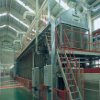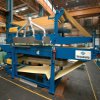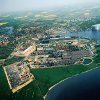Continuous pressing: changing the face of panel production
22 October 2003In 1952 the English-based company, Bartrev, developed a continuous press with rotating hot platens, of which seven were manufactured in all. This concept failed to become a commercial success, however, because the excessive technical complexity involved was not offset by any improvement in board tolerances over that possible with cycle presses. Furthermore, the market was not ready at the time for a fundamentally new type of press technology.
Some 20 years later, Bison built a continuous press for its own particleboard production based on the same principle of the rotating hot platen. This concept was not a commercial success either, for the same basic reasons.
An improved concept involving the use of roller chains was then developed in 1975/76 by Küsters. For the first time a concept was presented which led to improved board tolerances and finally attracted interest from industry. Even so, there were still problems and interruptions to production, this time because of the complex chain system, although these problems have long been resolved.
Siempelkamp contends that it was not until the development of its rotating rod system in 1982 that a high level of operational reliability was finally guaranteed and the real breakthrough came for the continuous press process – in the form of the company’s ContiRoll System.
Today, the continuous manufacturing process is the undisputed leader in terms of technological development. And now, as ever, it continues to find new areas of application, while existing processes are continually improved and refined.
Important examples of such innovations include continuous OSB production, which Siempelkamp was the first to master (the first plants were delivered to Kronopol and Huber in 1996), the production of thin MDF (the first Siempelkamp plant was delivered to Homanit, Herzberg, in 1991) and the production of very light MDF insulation panels on continuous presses. In the case of thin MDF in particular, Siempelkamp has put in a considerable amount of development work in order to achieve surfaces suitable for lacquering without the need for prior sanding.
For the future, a still higher feeding rate, combined with a further shortening of heating cycles, is an important development goal for continuous presses.
The permanent trend towards ever shorter heating times is made possible by advances in press technology, heating technology and, increasingly, gluing technology.
For some time now there has been a trend towards longer and, to some extent, wider presses. The reason for this is that operators wish to achieve maximum production outputs in return for minimum fixed costs.
As part of this development Siempelkamp has delivered a press over 60m long for an OSB line in North America. Plants of this size can achieve daily production volumes of over 2,000m3, at a good level of availability. A question often asked, therefore, is whether we can expect to see 70 or 80m long presses in the near future.
As far Siempelkamp is concerned, we actually expect to see a reverse in the trend. Tomorrow?’s presses are going to have to be faster, but also simpler and shorter, in order to offer better value for money.
This will be achieved through greater use of pre-heating systems which will take a considerable load off the press itself. Their use results in shorter heating times and better product quality.
Plastification of the mat leads to lower press pressures, less plant wear and adapted press structures. The first successful preheating system, the ContiTherm, was developed by Siempelkamp in 1999 for OSB production and is now available for MDF presses as well.
Gluing technology
Another major stimulus for improvements in productivity is provided by gluing technology. Traditionally, this has received little attention compared to that lavished on the spectacular advances in press construction. Here, too, we expect things to change in future.
This will be made possible by developments both on the glue/resin side and the glue spreading side. The tailoring of resins to different wood based panels is getting better all the time. Diverse glue manufacturers are working intensively on the production of faster resins. And resin spreading systems themselves have also been improved (for instance by Imal), resulting in reduced glue consumption.
The common objective of all these developments is the optimisation of gluing technology for high productivity through reduced glue consumption, optimised glue distribution and ultra-short setting times.
An important additional requirement is compliance with stricter environment-related regulations in relation to the production and use of wood based panels. Siempelkamp’s engineers are optimistic that they can master these complex technological requirements.
Trends in plant design:
In recent years, after a phase of consolidation, the major producers of wood based panels have built up large panel centres (socalled mega-sites).We expect this to continue.
This kind of strategy offers a range of advantages for plant operators, but also for plant manufacturers and panel buyers.
In our view, there are advantages for plant suppliers as well as plant operators to be gained from being able to design individual plants for a tightly defined range of products. This is simpler for both sides, and for the plant operator it is much more productive.
The long-standing practice of trying to produce many products from a family of products on a single plant inevitably leads to compromises. Moreover, frequent product changeovers result in unnecessary losses, and a very high level of investment is required in finishing equipment.
A good example is the successful strategy pursued for MDF laminate flooring plants. In these plants, the entire production process – from gluing to pressing, finishing, lamination and packaging – can be optimised for a single product.
Therefore, a successful strategy for the future has to be to set up more of these wood based panel centres, preferably linked to major sawmills. Other specialized lines can also be integrated at any time in addition to the standard equipment, ie particleboard, OSB and MDF plants. They can include, for instance, the flooring lines just mentioned, or exclusive lines for thin board, insulation board or PSL beams (boards made of long chips, lengthwise oriented).
The logistical advantages of such concepts are enormous. Thanks to the diversity of products it is possible to completely utilise all the different raw materials.Works management, maintenance, stocks of replacement parts and sales can all be centralized and therefore cost much less.
The advantage for the buyer of wood based materials is that all product ranges are available at short notice. This means that small quantities can be produced and dispatched cost-effectively as job orders.
In the near future we shall see major advances in productivity resulting from the combination of state-of-the-art press systems and improvements in technology. Supplemented by modern logistics systems, which embrace the entire value-added chain from raw material to distribution, the production of wood based materials in a continuous process will continue to successfully dominate its market.
Longer term we anticipate the introduction of new technologies and products based on existing processes.
Composite materials provide just one example. Wood-plastic composites achieved a dominant market position in motor vehicle accessories a few years ago, and there is no doubt that similar composite materials can establish themselves in the market for wood based panels and related areas. This development has already begun in the production of mouldings.
The chances of continuous panel production being substituted by alternative technologies do not appear remotely realistic in the foreseeable future. At Siempelkamp, we see ourselves confirmed in this belief by the optimised technology of our processes and by the high return on investment and availability offered by our plants as a whole.


